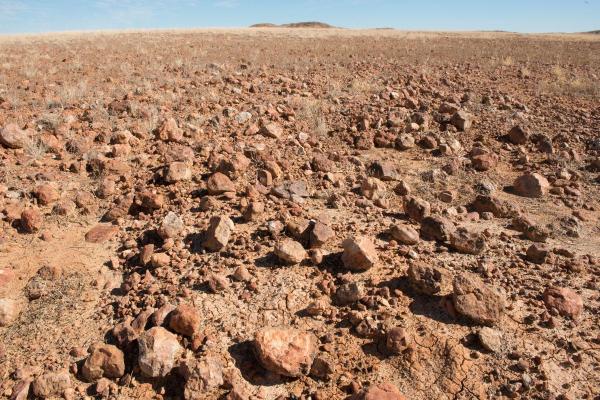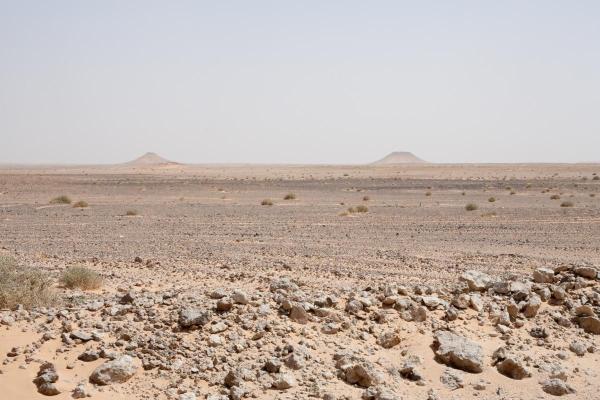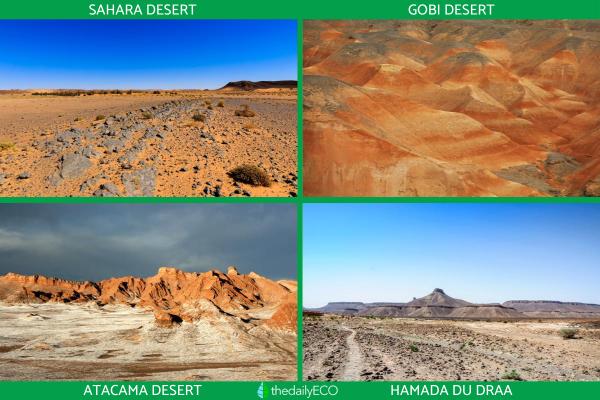
Desert pavements are arid topographical regions which are characterized by a surface covered in rocks, pebbles or gravel with little or no sand. While we might most associated deserts with sand, desert pavements represent a very large portion of this planet's desert areas. Of great importance to their respective ecosystems, they are formed by the erosion of rocks due to wind, water and temperature fluctuations. Some examples are the Gobi Desert, the Atacama Desert and Hamada du Draa. We discover more about the formation and examples of these geological landforms with our thedailyECO article which asks what is a desert pavement?
What are desert pavements?
Desert pavements are vast expanses of arid land characterized by being covered primarily with stones, gravel and rocks, but which lack sand. Sandy deserts are associated with large shifting dunes, but desert pavements feature a firm and rocky surface that can extend for miles. These landform areas are found in different regions of the world and represent a significant portion of the planet's different types of deserts.
Desert pavements are given different names depending on their location around the world. In North Africa they are known as a ‘reg’, especially in the western Sahara. In the eastern part of this desert they are more commonly known as a ‘serir’. In Australia, they are often known as ‘gibbers’.
These terms refer to a plain covered in compacted stones and pebbles, left exposed after the wind has blown away the finest sand particles. There are similar, but distinct landforms such as hamadas. These are plateaus which are formed by long-term wind erosion which exposes large boulders over a very vast difference.
At first glance, desert pavements may appear to be hostile and inert terrain, but they possess unique characteristics that differentiate them from other types of desert:
- Rocky and stable surface: unlike sandy deserts, rocky plains offer firmer ground that makes vehicle traffic easier than shifting dunes.
- Extreme temperatures: desert pavements experience extreme temperature variations, with very hot days and extremely cold nights.
- Low vegetation: plant life is scarce due to the lack of water and infertile soil. Only a few drought-adapted plants manage to survive in these environments, such as shrubs and cacti. Discover some of the types of cactus without spines which might be found in such an ecosystem.
- Visible erosion: it is common to observe rock formations eroded by the action of wind and sand, creating landscapes with curious and unique shapes.
To learn more about how desert ecosystems operate, take a look at our article explaining what the desert climate is like.

How is a desert pavement formed?
The formation of desert pavements is a geological and climatic process that occurs over thousands or even millions of years. The main stages of desert pavement formation are detailed below:
1. Rock weathering: fragmentation by natural agents
The first step in the formation of desert pavements is weathering. Mechanical or physical weathering is the breakdown down of larger rocks into smaller particles without altering their chemical composition. This mechanical weathering process is caused by:
- Extreme temperature fluctuations: intense heat during the day causes rocks to expand, but very low temperatures cause them to contract at night. Over time, this repeated expansion and contraction creates cracks that eventually decompose the rocks.
- Wind and water action: although deserts are arid, occasional rains and strong winds contribute to the weathering of rocks, accelerating their fragmentation.
Water and wind erosion can also help to form desert pavements. Erosion is distinct from weathering because it occurs due to the displacement and transportation of solids. Weathering causes decomposition and it occurs in the same place.
You can learn about how water affects the formation of landforms with our article asking what is river erosion?
2. Removal of fine particles: deflation and wind erosion
In arid regions, wind is a key agent in erosion. This is an eolian process known as deflation which involves the removal of lighter sediments such as sand and dust carried by air currents. As a result, only heavier materials such as gravel and stones remain on the surface.
3. Soil compaction and stabilization
The removal of the finer sediments over time gives way to a layer of rocks and pebbles that protects the underlying soil from further erosion and weathering. This rocky mantle acts as a natural barrier against wind action, stabilizing the landscape and preventing the surface from being easily washed away.
4. Formation of a hard and resistant surface
As the rocks become exposed, they can form a compact crust on the ground. Minerals in the soil and occasional precipitation can help consolidate this layer, producing a more stable and erosion-resistant surface. This structure is characteristic feature of desert pavements. This set of processes (weathering, wind erosion, deflation, compaction and consolidation of the ground) is what gives rise to the desert pavements around the world.
Examples of desert pavements
Some of the most extensive desert pavements around the world include the following:
- Sahara Desert (Africa): the Sahara Desert is the largest hot desert in the world, covering approximately 9.2 million km². Although it's often associated with sand dunes, more than 70% of its surface is actually rocky.
- Gibson Desert (Australia): covering approximately 156,000 km², it is largely composed of a type of desert pavement known locally as a gibber. These surfaces are covered with a dense layer of boulders that have been smoothed by wind erosion.
- Gobi Desert (Mongolia and China): the Gobi Desert covers approximately 1.3 million km² and is another prominent example of a desert pavement. Although it has some areas of dunes, most of the Gobi is composed of gravel and rock plains. This makes it a type of cold desert due to its extremely cold winters.
- Atacama Desert (Chile): located in northern Chile, the Atacama Desert is one of the driest places on the planet, with rainfall of less than 1 mm per year in some areas. Although it has some dunes, a large portion of its surface is bare rock and gravel.
- Hamada du Draa (Morocco and Algeria): the Hamada du Draa is a large rocky plateau located in the Western Sahara, on the border between Morocco and Algeria. It is a classic example of a hamada, dominated by eroded rocks and boulders, but it does also contain large areas of desert pavement in and around the hamada.
- Karakum Desert (Turkmenistan): the Karakum Desert occupies about 70% of Turkmenistan's territory and covers more than 350,000 km². Although it has some dunes, most of it is a desert pavement with areas of gravel and compacted soil.
Desert pavements are only one type of landform which can be found in deserts. Learn about another which is very important to local communities with our article asking what is an oasis in a desert?

If you want to read similar articles to What Is a Desert Pavement?, we recommend you visit our Ecosystems category.
- Rocky Desert or Hamada. (2019). Qatar e-Nature.
https://www.enature.qa/ecosystem/rocky-desert-or-hamada/ - Rocky desert. (n.d.) Nature Spots.
https://www.naturespots.net/habitats/dunes-deserts/12759-rocky-desertl